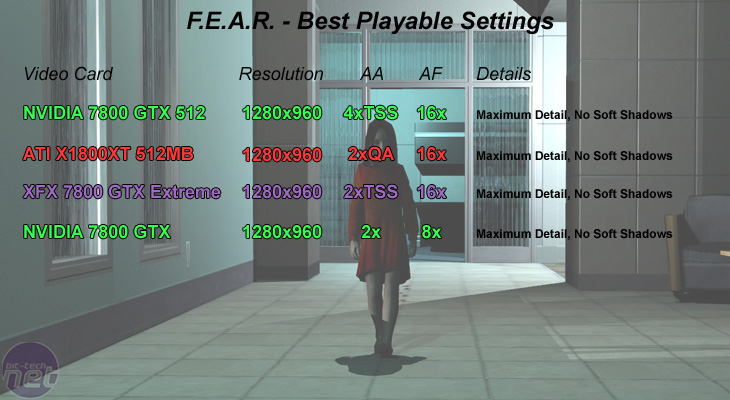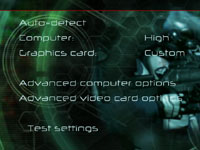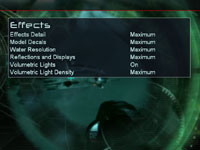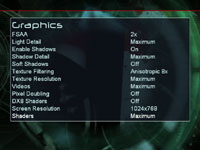
F.E.A.R.
Publisher: VU GamesWe used the full retail version of F.E.A.R. patched to version 1.02. The game makes use of a lot of effects - including Soft Shadows, Volumetric Lighting, Parallax Mapping and Particle Effects, along with a slow-motion mode that really taxes today's top of the line GPU's. There's extensive use of high resolution textures. The walls are both Bump Mapped and Parallax Mapped to give a realistic feel to the brick walls that are a big feature of this title. Also, the world is incredibly destructible, which is made more realistic by Parallax Mapping.
In general, this is a graphically intense game and the most outstanding part of the graphics engine is undoubtedly the player character's shadow that is cast on the wall.
It also has the most advanced A.I. that we have ever seen in a game engine to date - there are times when you'll find yourself with your pants down around your ankles with no where to go. For anyone who hasn't bought this game yet, we highly recommend you do - check out our full F.E.A.R. review .
We did a manual run-through from the "Heavy Resistance" level, between two save game checkpoints - it was a section of intense outdoor gameplay that lasted around three and a half minutes. We recorded frame over time graphs for all of our manual run-throughs because we found that the SloMo mode dropped our frame rates in to the low teens. We suspect this drop is part of Monolith's technique for slowing down the gameplay, as the game was not as jerky as the frame rate suggests.
Anti-Aliasing and Anisotropic Filtering were controlled from inside the game, and thus drivers were left set to "Application Controlled".
Below is a table of the best-playable settings that we found best for each video card configuration. We decided that a minimum frame rate of around 15 frames per second and an average of over 40 frames per second would deliver a good gaming experience throughout the rest of the title.

When we applied 4xTSS AA 16xAF at 1280x960, we found that the frame rate took quite a hit, and delivered an average frame rate of 39 frames per second, while the minimum frame rate we recorded was 14 frames per second. If you have a powerful CPU, you will be able to experience F.E.A.R. at the highest settings we've seen for a single card configuration - the thought of two of these running F.E.A.R. in SLI mode is an exciting prospect.
If you don't have a CPU as powerful as our Athlon 64 X2 4800+, we'd recommend dropping down to 1280x960 2xTSS AA 16xAF, and getting an unparalleled gaming experience. We also tried to play the game at 1600x1200 0xAA 16xAF, but found that the average frame rate dropped well below 35 frames per second, and the minimum was into single figures. To put it bluntly, we've never experienced anything quite as fast as this from a single GPU.

MSI MPG Velox 100R Chassis Review
October 14 2021 | 15:04








Want to comment? Please log in.